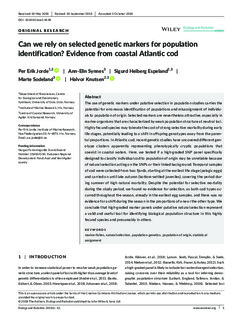| dc.description.abstract | The use of genetic markers under putative selection in population studies carries the potential for erroneous identification of populations and misassignment of individuals to population of origin. Selected markers are nevertheless attractive, especially in marine organisms that are characterized by weak population structure at neutral loci. Highly fecund species may tolerate the cost of strong selective mortality during early life stages, potentially leading to a shift in offspring genotypes away from the parental proportions. In Atlantic cod, recent genetic studies have uncovered different genotype clusters apparently representing phenotypically cryptic populations that coexist in coastal waters. Here, we tested if a high‐graded SNP panel specifically designed to classify individual cod to population of origin may be unreliable because of natural selection acting on the SNPs or their linked background. Temporal samples of cod were collected from two fjords, starting at the earliest life stage (pelagic eggs) and carried on until late autumn (bottom‐settled juveniles), covering the period during summer of high natural mortality. Despite the potential for selective mortality during the study period, we found no evidence for selection, as both cod types occurred throughout the season, already in the earliest egg samples, and there was no evidence for a shift during the season in the proportions of one or the other type. We conclude that high‐graded marker panels under putative natural selection represent a valid and useful tool for identifying biological population structure in this highly fecund species and presumably in others. | nb_NO |
